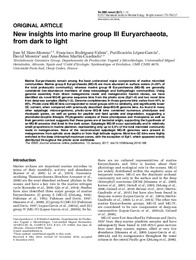Por favor, use este identificador para citar o enlazar este ítem:
https://hdl.handle.net/11000/4843Registro completo de metadatos
| Campo DC | Valor | Lengua/Idioma |
|---|---|---|
| dc.contributor.author | Haro Moreno, José Manuel | - |
| dc.contributor.author | Rodríguez Valera, Francisco | - |
| dc.contributor.author | López García, Purificación | - |
| dc.contributor.author | Moreira, David | - |
| dc.contributor.author | Martín Cuadrado, Ana Belén | - |
| dc.contributor.other | Departamentos de la UMH::Producción Vegetal y Microbiología | es |
| dc.date.accessioned | 2018-10-03T11:08:46Z | - |
| dc.date.available | 2018-10-03T11:08:46Z | - |
| dc.date.created | 2017-01-13 | - |
| dc.date.issued | 2018-10-03 | - |
| dc.identifier.issn | 1751-7370 | - |
| dc.identifier.uri | http://hdl.handle.net/11000/4843 | - |
| dc.description.abstract | Marine Euryarchaeota remain among the least understood major components of marine microbial communities. Marine group II Euryarchaeota (MG-II) are more abundant in surface waters (4–20% of the total prokaryotic community), whereas marine group III Euryarchaeota (MG-III) are generally considered low-abundance members of deep mesopelagic and bathypelagic communities. Using genome assembly from direct metagenome reads and metagenomic fosmid clones, we have identified six novel MG-III genome sequence bins from the photic zone (Epi1–6) and two novel bins from deep-sea samples (Bathy1–2). Genome completeness in those genome bins varies from 44% to 85%. Photic-zone MG-III bins corresponded to novel groups with no similarity, and significantly lower GC content, when compared with previously described deep-MG-III genome bins. As found in many other epipelagic microorganisms, photic-zone MG-III bins contained numerous photolyase and rhodopsin genes, as well as genes for peptide and lipid uptake and degradation, suggesting a photoheterotrophic lifestyle. Phylogenetic analysis of these photolyases and rhodopsins as well as their genomic context suggests that these genes are of bacterial origin, supporting the hypothesis of an MG-III ancestor that lived in the dark ocean. Epipelagic MG-III occur sporadically and in relatively small proportions in marine plankton, representing only up to 0.6% of the total microbial community reads in metagenomes. None of the reconstructed epipelagic MG-III genomes were present in metagenomes from aphotic zone depths or from high latitude regions. Most low-GC bins were highly enriched at the deep chlorophyll maximum zones, with the exception of Epi1, which appeared evenly distributed throughout the photic zone worldwide | en |
| dc.description.sponsorship | This work was supported by projects MEDIMAX BFPU2013–48007-P from the Spanish Ministerio de Economía y Competitividad | - |
| dc.description.sponsorship | MaCuMBA Project 311975 of the European Commission FP7 | - |
| dc.description.sponsorship | Project AQUAMET II/2014/012 from the Generalitat Valenciana and by the French Agence Nationale de la Recherche (ANR-08-GENM-024–001,EVOLDEEP). | - |
| dc.description.sponsorship | JHM was supported with a PhD fellowship from the Spanish Ministerio de Economía y Competitividad. | - |
| dc.format | application/pdf | en |
| dc.format.extent | 75 | es |
| dc.language.iso | eng | en |
| dc.rights | info:eu-repo/semantics/openAccess | en |
| dc.subject.other | 579 - Microbiología | es |
| dc.title | New insights into marine group III Euryarchaeota, from dark to light | es |
| dc.type | info:eu-repo/semantics/article | en |
| dc.identifier.doi | 10.1038/ismej.2016.188 | - |
| dc.relation.publisherversion | https://doi.org/10.1038/ismej.2016.188 | - |

Ver/Abrir:
New insights into Marine Group....pdf
4,01 MB
Adobe PDF
Compartir:
 La licencia se describe como: Atribución-NonComercial-NoDerivada 4.0 Internacional.
La licencia se describe como: Atribución-NonComercial-NoDerivada 4.0 Internacional.
.png)